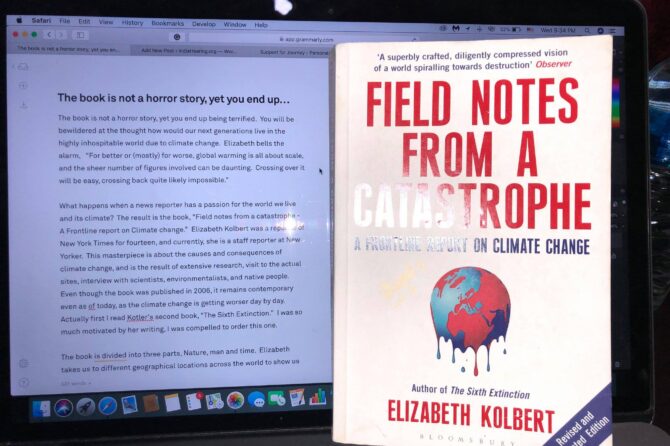
The book is not a horror story, yet it leaves you terrified. You’ll be bewildered by the thought of how our next generations will live in the highly inhospitable world that climate change is creating. The author rings the alarm bell: “For better or (mostly) for worse, global warming is all about scale, and the sheer number of figures involved can be daunting. Crossing over will be easy, crossing back quite likely impossible.“
What happens when a news reporter is passionate about the world we live in and its climate? The result is the book “Field Notes from a Catastrophe: A Frontline Report on Climate Change.” Elizabeth Kolbert was a reporter for The New York Times for fourteen years and is currently a staff writer at The New Yorker. This masterpiece, which discusses the causes and consequences of climate change, is the result of extensive research, visits to actual sites, and interviews with scientists, environmentalists, and indigenous peoples. Although the book was published in 2006, it remains contemporary even today as climate change continues to worsen. I first read Kolbert’s second book, “The Sixth Extinction,” and was so inspired by her writing that I felt compelled to order this one.
Kolbert takes us to various geographical locations around the world to show us the warning signs of global warming, such as the shrinking of glaciers, the severity of forest fires, melting permafrost, the warming and increasing acidity of the oceans, the narrowing gap between daytime and nighttime temperatures, the northward shifting of animal ranges, and the melting of the Arctic. She explains how the melting of Greenland’s ice alone is predicted to raise sea levels by 23 feet. Then, with the example of a butterfly and a toad, she illustrates how global climate destabilization has impacted the lives of many species and led to the extinction of multiple species. She also highlights the dangers of greenhouse gases, including chlorofluorocarbons (CFCs).
Kolbert expresses dismay that the United States produces roughly 25 percent of the world’s greenhouse gases yet has not ratified the Kyoto Protocol. She discusses the possible connection between the devastating hurricanes that frequently hit the United States and global warming, even though it is uncertain. She also expresses frustration with developments in the Third World, which are not restricted by the Kyoto Protocol.
Kolbert presents solutions to fight climate destabilization as proposed by Robert Socolow and Stephen Pacala. They suggest a set of fifteen “stabilization wedges,” each of which could prevent one billion metric tons of carbon dioxide from being emitted by 2054. Of these, as many as twelve are required to contain the current pace of climate change!
Elizabeth strongly believes, “Humans aren’t the first species to alter the atmosphere; that distinction belongs to early bacteria, which, some two billion years ago, invented photosynthesis. But we are the first species to be in a position to understand what we are doing.” This book contains extensive scientific material, which may deter some readers. However, given the dire consequences of climate change, it is a must-read for every human being.
Prof. Dr. Prahlada N. B
16 January 2019
Chitradurga.

















Leave a reply